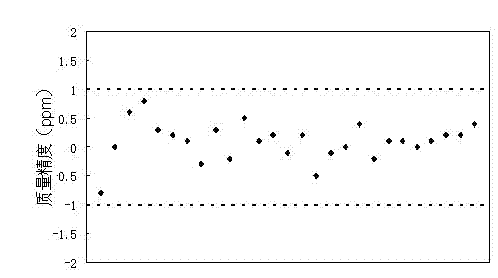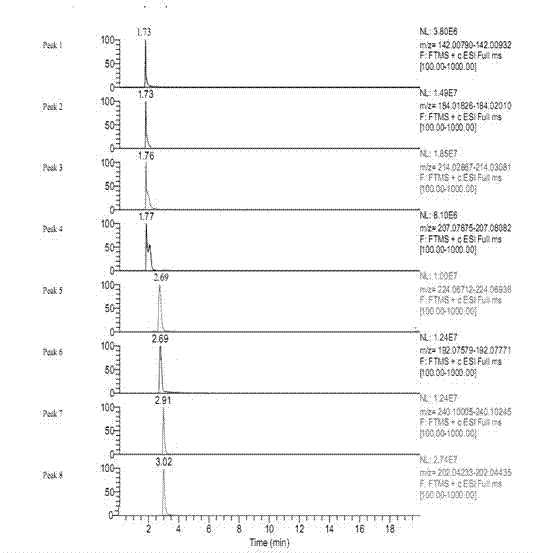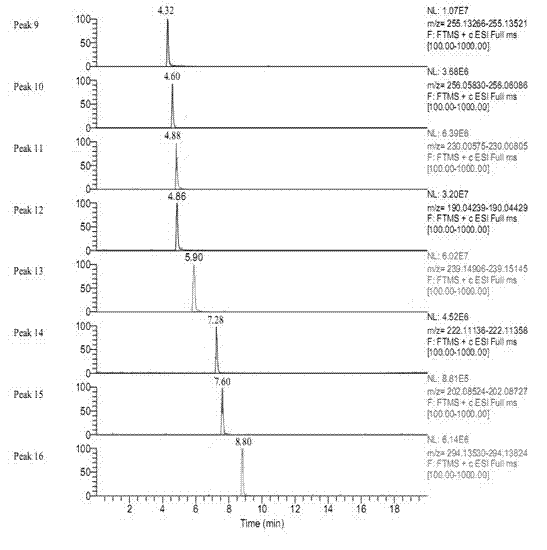Method for detecting residual quantity of pesticides in vegetable sample by utilizing liquid chromatogram-high resolution mass spectrometer
A high-resolution mass spectrometry and pesticide multi-residue technology, which is applied in the field of liquid chromatography high-resolution mass spectrometry to detect multi-pesticide residues in vegetable samples, can solve non-target compound interference, reduce the impact on qualitative and quantitative, qualitative and quantitative problems, etc., Achieve the effects of reducing pesticide misjudgment, simplifying sample purification, and rapid analysis
- Summary
- Abstract
- Description
- Claims
- Application Information
AI Technical Summary
Problems solved by technology
Method used
Image
Examples
Embodiment 1
[0033] 1. Instruments and reagents
[0034] Instruments: Thermo Scientifc LTQ-Orbitrap XL combined high-resolution mass spectrometer (Thermo Electric Company, USA), SURVEYOR-HPLC liquid chromatograph (Thermo Electric Company, USA), high-speed dispersing machine (IKA Company, Germany).
[0035]Reagents: acetonitrile (chromatographically pure, Merck, Germany); acetone, toluene, formic acid (chromatographically pure, Tedia, USA); PSA and C18 packing (particle size 40 μm, Varian); anhydrous magnesium sulfate (analytical pure, Sigma - Aldrich Company); sodium chloride (analytical grade, Shanghai Shisi Hewei Chemical Co., Ltd.), ammonium acetate (analytical grade, American Fluka Company); water is Milli-Q high-purity water; 5mmol / L ammonium acetate containing 0.1% formic acid : Dissolve 0.385g of ammonium acetate in water, then add 1mL of formic acid and dilute to 1000mL with water. 80 kinds of pesticide standard products (purity not less than 95%, Dr Ehrenstorfer Company), were pr...
Embodiment 2
[0053] 1. Sample processing
[0054] (1) Sample extraction: Weigh 30 g of a uniform sample (vegetable matrix) and place it in a 200 mL plastic centrifuge tube, add 35 mL of acetonitrile, place it in a high-speed disperser at 8000 r / min for 3 min, and then add 20g compound salt (mass ratio of anhydrous magnesium sulfate and sodium chloride 10:1), homogenate at 10000 r / min for 2 minutes, and finally, place the centrifuge tube in a centrifuge and centrifuge at 5000 r / min for 6 minutes.
[0055] (2) Sample purification: Take 2mL of the upper acetonitrile phase into a 20mL centrifuge tube, add 0.6g of anhydrous magnesium sulfate, 0.05g of PSA, and 0.05g of C18, shake on a vortex shaker for 2min, then place the centrifuge tube in a centrifuge Centrifuge at 8000 r / min for 3 min. The supernatant was passed through a 0.22 μm organic filter membrane for testing.
[0056] 2. Preparation of standard working solution
[0057] Accurately weigh standard products: methamidophos, acephate, ...
Embodiment 3
[0068] 1. Sample processing
[0069] (1) Sample extraction: Weigh 50g of a uniform sample (Chinese cabbage matrix) and place it in a 200mL plastic centrifuge tube, add 50mL of acetonitrile, place it in a high-speed disperser at 12000 r / min and homogenize for 3min, then pour it into the centrifuge tube Add 25g of compound salt (mass ratio of anhydrous magnesium sulfate and sodium chloride 10:1), homogenize at 12000 r / min for 3 minutes, and finally place the centrifuge tube in a centrifuge and centrifuge at 3000 r / min for 4 minutes.
[0070] (2) Sample purification: Take 6mL of the upper acetonitrile phase into a 20mL centrifuge tube, add 1.8g of anhydrous magnesium sulfate, 0.2g of PSA, and 0.2g of C18, shake on a vortex shaker for 1.5min, then place the centrifuge tube in a centrifuge In the machine, centrifuge at 12000 r / min for 4 minutes. The supernatant was passed through a 0.22 μm organic filter membrane for testing.
[0071] 2. Preparation of standard working solution ...
PUM
| Property | Measurement | Unit |
|---|---|---|
| Particle size | aaaaa | aaaaa |
Abstract
Description
Claims
Application Information
 Login to View More
Login to View More - R&D
- Intellectual Property
- Life Sciences
- Materials
- Tech Scout
- Unparalleled Data Quality
- Higher Quality Content
- 60% Fewer Hallucinations
Browse by: Latest US Patents, China's latest patents, Technical Efficacy Thesaurus, Application Domain, Technology Topic, Popular Technical Reports.
© 2025 PatSnap. All rights reserved.Legal|Privacy policy|Modern Slavery Act Transparency Statement|Sitemap|About US| Contact US: help@patsnap.com



